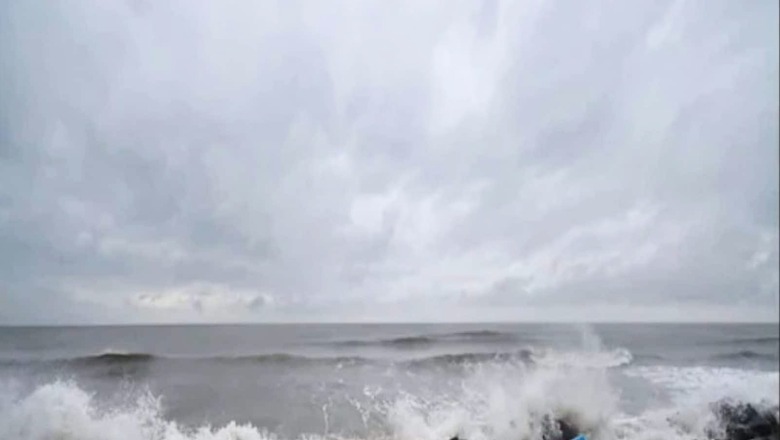
views
Clearly, Cyclone Ockhi was an unusual phenomenon. Unlike any other cyclone before, it did not just rapidly intensify but also left the scientists bewildered with its long gestation period. It developed in the sea for 6.7 days, much longer than the average life of 4.7 days observed for ‘very severe cyclonic storms’ that had occurred over the north Indian Ocean (the Bay of Bengal and the Arabian Sea) until 2017. And, both these peculiarities put the scientists on alert of what was likely in the near future.
Definitely, we have come a long way since Ockhi struck in 2017.
The scientists now use the ocean-atmosphere coupled models that have made the early forecast of cyclones and their intensity more accurate. The error in landfall point and track-forecast of cyclones has reduced tremendously. Starting this March, the India Meteorological Department (IMD) has also begun sharing the pre-genesis track and intensity forecast at the stage of low pressure (the starting point of any cyclone). It is also believed to be the first weather centre to initiate such a forecast worldwide.
The IMD’s impact-based forecasts inform people of not just what the weather is but what it could possibly do. The early warnings have yielded results, and India has successfully brought down the loss of lives in cyclones from thousands to now less than a hundred.
Nonetheless, we need to admit that climate change has outpaced our abilities and preparedness to counter its devastating impacts. Several cyclones have ravaged the eastern and the western coasts of India, and left a trail of destruction, with mounting economic losses. Each of these storms has been unique and different from the other, signalling how challenging it will be to predict these extreme events in the future. The pace at which some of these cyclones have gained intensity remains most disconcerting.
Warming seas and intense cyclones
The north Indian Ocean is warming at a faster pace, and it continues to throw newer challenges at us. The warmer sea-surface temperatures are supercharging these storms at the early and mature stages, and are likely to make the strongest cyclones even more intense in the coming years.
When Super-cyclone Amphan cruised its way through the West Bengal coast in May 2020, it intensified from Category 1 to Category 5 in a record time of about 18 hours and was the strongest storm to form over the Bay of Bengal since the 1999 Odisha Cyclone. Just before Amphan was forming, the buoys installed in the Bay of Bengal recorded surface temperatures as high as 32-34°C, validating what the scientists had been warning all along. The world is hotter than ever before.
In 2019, the Arabian Sea, which normally sees 1-2 cyclonic disturbances a year, recorded five— its most intense cyclone season ever. Fani, which ravaged the eastern coast the same year, was the longest-lasting cyclone in April over the Bay of Bengal in a century, with a lifecycle of 11 days.
“One of the biggest challenges that we are facing is the rapid intensification of these cyclones in a very short interval. Apart from that, we are also seeing an increase in the duration of some of these cyclones in the sea. The longer a system remains in the sea, the more energy it draws from it, which helps it to intensify further,” says Dr Roxy Mathew Koll, climate scientist at the Indian Institute of Tropical Meteorology (IITM), Pune. “These are clear climate signals, and each time a cyclone strikes, it’s not just the storm but multiple events that we need to account for— storm surges, extreme rainfall, flooding/inundation — and all of it relies on extensive and timely data.”
Need to amp up research and data collection
A warmer sea is a key ingredient for the formation of any storm, which makes the ocean temperatures or the Tropical Cyclone Heat Potential (THCP) the most crucial element in predicting them. While there are a number of on-site instruments or buoys installed in the adjoining seas, they may not be adequate enough to gather the kind of humongous data that would be required in the near future to predict these extreme events. A lot of it is also marred by resolution issues.
Our research capabilities will need to be strengthened further with more investment in specialised studies. The gap in data measurement and collection for sea surface/subsurface temperatures, round-the-clock satellite imagery, and wind measurements will need to be plugged in. It will have to factor in the variables and uncertainties expected in the future. There are still a lot of questions that need to be addressed to explain the future occurrence of these extreme events, and the lack of adequate and quality data must not prove to be a hindrance.
Global warming cannot be stopped. In fact, it is accelerating.
Accompanied by climate change, the Indian Ocean will continue to throw newer challenges at us and cyclones are most likely to remain its most visible manifestations. With an over 7,500-km-long coastline covering as many as 72 vulnerable districts, it is urgent and necessary that our current research and forecast capabilities keep pace with the widespread, rapid, and intense impacts of climate change to prevent them from overwhelming us.
Read all the Latest News India and Breaking News here


















Comments
0 comment